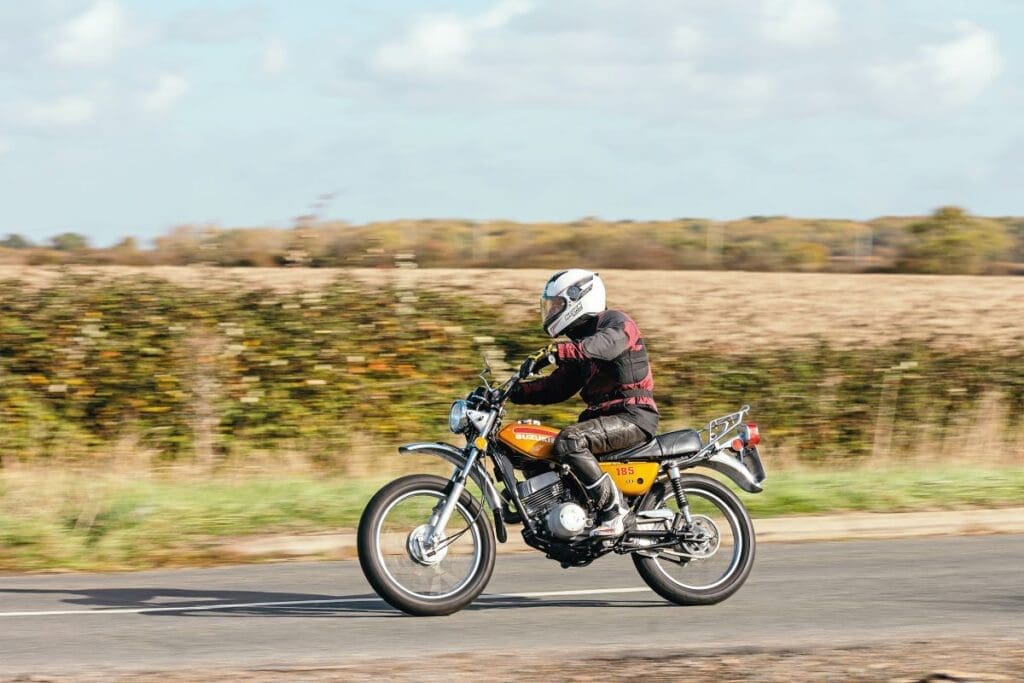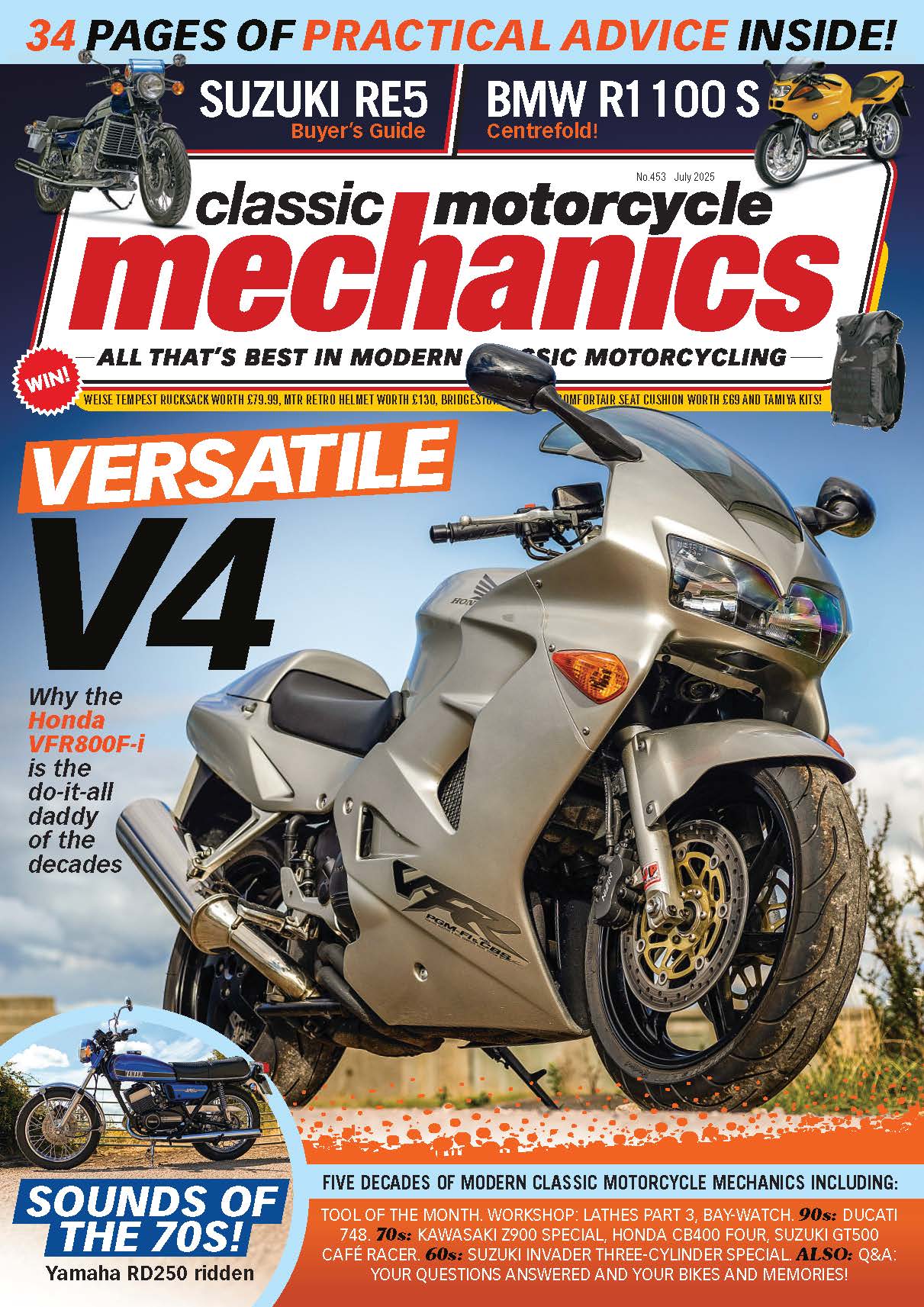This is Suzuki’s other 185 trail bike – the one that’s not a TS. We ride Suzuki’s TC185.
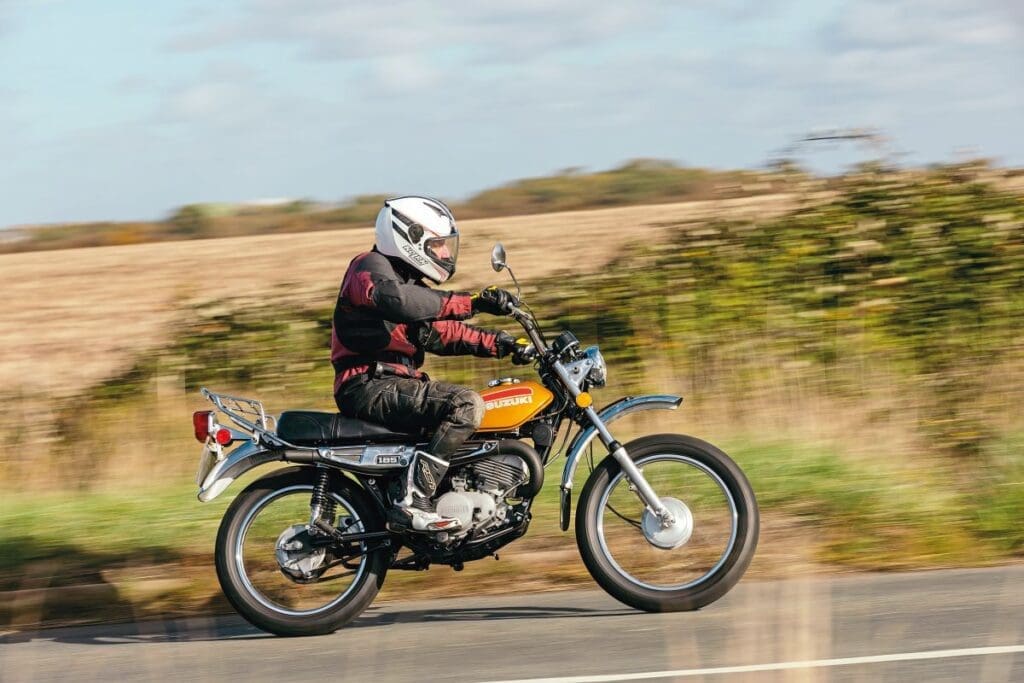
Words: Steve Cooper Pics: Gary Chapman
Oh – yawn – just another 1970s stroker trail bike you say… wrong! Yes, so it might look like just about any other Suzuki dual-purpose machine of the period, but this one is a little different if you care to delve deeper.
Our bike in camera rather disproves the old adage: if it looks like a duck, quacks like a duck and moves like a duck it has to be a duck. It may look like a TS185, sound like a TS185, and certainly moves like a TS185, but it isn’t a TS185. Low and behold it’s a TC185! A what? Yes, precisely!
Without doubt much of what’s visible seems to be very much TS sourced but, as is the way of these things, the devil is in the detail. Look carefully at the left-hand side of the piston-ported motor and you’ll spot a strange lever arrangement. This has a pair of cleated plates rather like a brake pedal at either end and is attached to a shaft that disappears into the bowels of the engine cases. And, perhaps rather confusingly, there’s an ordinary gear lever just a few inches below it – so what is going on here? Welcome to the slightly strange world of Suzuki product placement of the 1970s.
That double-ended lever actuates a secondary system within the gearbox area that changes the overall drive output. There’s still a conventional set of five cogs inside the gearbox but their drive exists via a dual ratio arrangement giving the rider the option of ‘Hi or Lo’ overall speeds. This composition of 10 ratios allowed the user to subject the bike to significantly more arduous conditions, i.e. genuine agricultural, forestry, rescue, hunting applications. The TS185 was the obvious choice for most potential buyers who wanted an everyday dual-purpose machine, but for those who wanted or needed greater, genuine, off-road capabilities the TC185 was the more obvious choice. In the Suzuki USA’s marketing spiel, where every bike had a moniker as well as a factory designation, the TC185 was nicknamed The Ranger, thereby implying its suitability to roam almost anywhere. And, to add to the bike’s versatility, Suzuki also fitted an electric-start facility on the end of the crank. The system utilised a substantial dynamo device that doubled up as a self-starter via a relay control box and an extra set of carbon brushes. A quick stab on the button soon had the motor running. Some might think such a fitment was unnecessary but when the rider was axles deep in a muddy creek such ostensible luxuries were genuinely game changers.
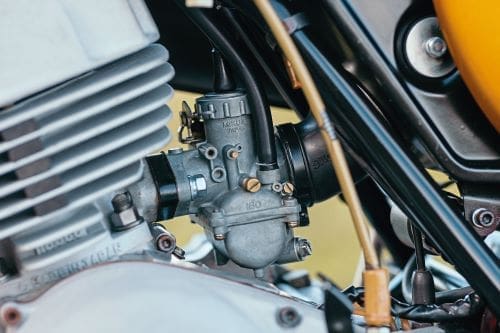
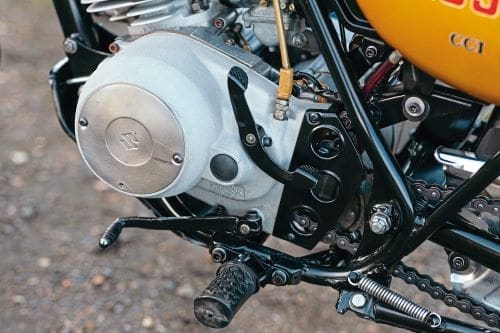

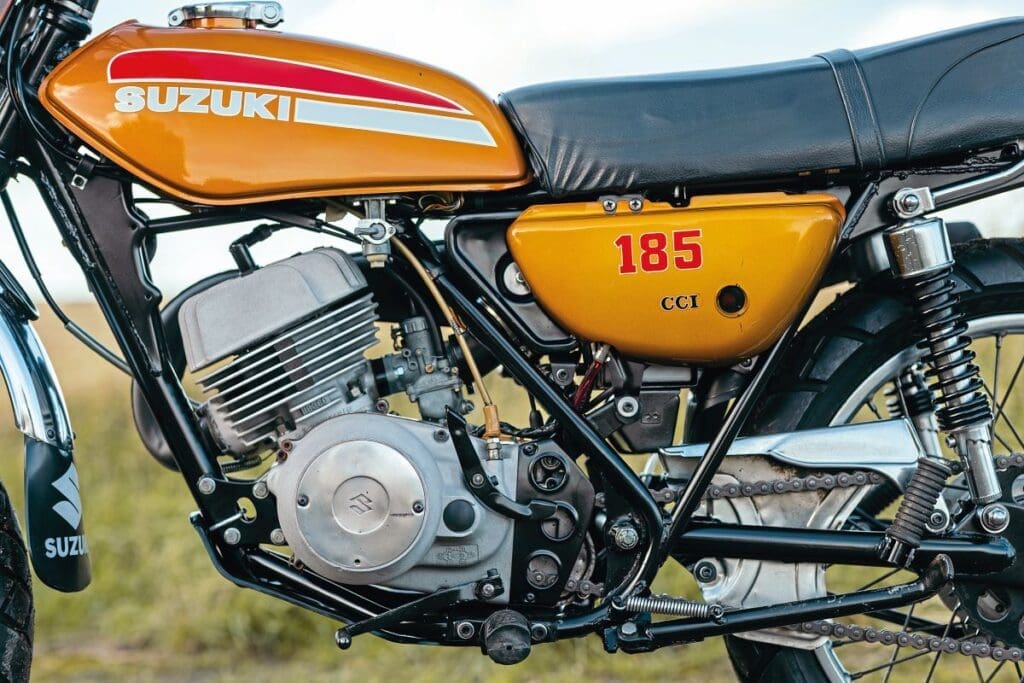
Despite being pretty much a USA and Australasia only bike, we have one to sample in rural Bedfordshire, courtesy of owner Roy Hook, and it’s very much a regularly used restoration and not a sterile museum piece. It would be a brave Japanese classics fan that argued against Suzuki not being at the top of their game when it came to styling at this point in time. That Candy Gold tank and left-hand side panel (the exhaust occupies the position on the right) scream 1970s at the top of their voice. Simple ‘flash’ graphics in red and grey with white borders add subtle highlights. During this period, bikes sold as much on looks as they did on capabilities, so what’s not painted gloss or satin black is slathered in the ubiquitous shiny stuff. It’s not what a modern off-road bike would wear today but back then lustrous chrome plate was the thing to be seen with. Heat shield, headlight and rear light assemblies, rack, wheel rims and guards all had the same finish.
Talking of guards, the front has a strange-looking mounting arrangement which has a flavour of being home-brewed or aftermarket, but it’s actually neither. Just like its little TC90 cousin which sports a similar device, the TC185 had this useful lifting device. As and when the bike’s front-end got bogged down in the mire, the rider could pull the wheel out via the robust tubular frame; more evidence that the bike had real off-road focus. And on that continuing theme of usability the bike has another concession to a hard life off-road. Under discrete rubber caps over the fork tops there’re screw adjusters giving three levels of preload at the springs to match the terrain. One area where the bike’s apparent off-road purposes conflict with what’s there is the chain-guard which is very much the chrome-plated mild steel format as used on the TS range. It’s vestigial at best and there’s neither a lower tensioner nor any form of lower guarding to protect the chain, which is somewhat at odds with the supposed purpose. Cost savings perhaps or just an oversight?
Elsewhere the bike is very much standard Suzuki fare of the period. The switch-gear, gauges, controls, lights, grips and so much more could be off almost any model from the Hamamatsu firm’s books. To a degree a reasonable amount of what’s here is TS185 based, including some of the running gear, bars, hinged footrests, sump-guard and the like. But then dig a little deeper through comparative parts lists for the TC and TS and it’s readily apparent that not everything is automatically TS based – and obviously not just the crankcases with that dual ratio transmission either. A straw poll taking data from period, online fiches, shows the chassis, carburettor, con-rod and even the rear light run subtly different parts numbers; which does rather make you wonder why Suzuki went down this particular route but more of this elsewhere. Reviewing the period factory brochures maximum torque is the same for both the TS and TC but the latter’s peak power is one horse down at 16bhp. Presumably the extra mass of the starter system handicapped the TC’s power output a little?
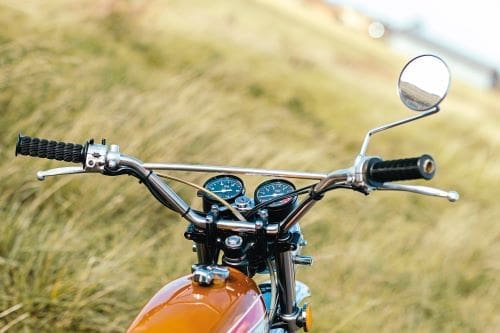


Out on the road we dispatch with all the technical stuff and get on with the job in hand – riding Suzuki’s largest capacity TC single-cylinder motorcycle. As the motor is already warm there’s no need for the flip-down choke and we fire it up by pushing the starter button. Immediately the tail pipe is emitting that characteristic pocka-pocka exhaust note reassuring that, yes, this a Hamamatsu-sourced, single cylinder, trial iron single. At the risk of sounding a little blasé here, if you have ever ridden a TS125, 185 or 250 the experience is most emphatically typical… and there is absolutely nothing wrong with that in any shape or form.
The motor is unquestionably the epitome of the genre and you’d really struggle to find a better fuelled, piston-ported, single of the period. Yes, okay, the TC’s motor doesn’t have the immediacy or snap delivery of a Kawasaki F-series trail bike with its disc-valve delivery, and neither does it have the almost liquid manner with which a reed-valved Yamaha DT, AT or CT supplies its motive force. No, the TC lays down its drive somewhere in between those two book-ends and it’s none the worse for it. There’re no glitches, hang-ups or surges from what is, on paper at least, a very simple motor. Suzuki’s R&D team’s got it bang on with carburettor, gas flow rates and exhaust all working in sweet harmony.
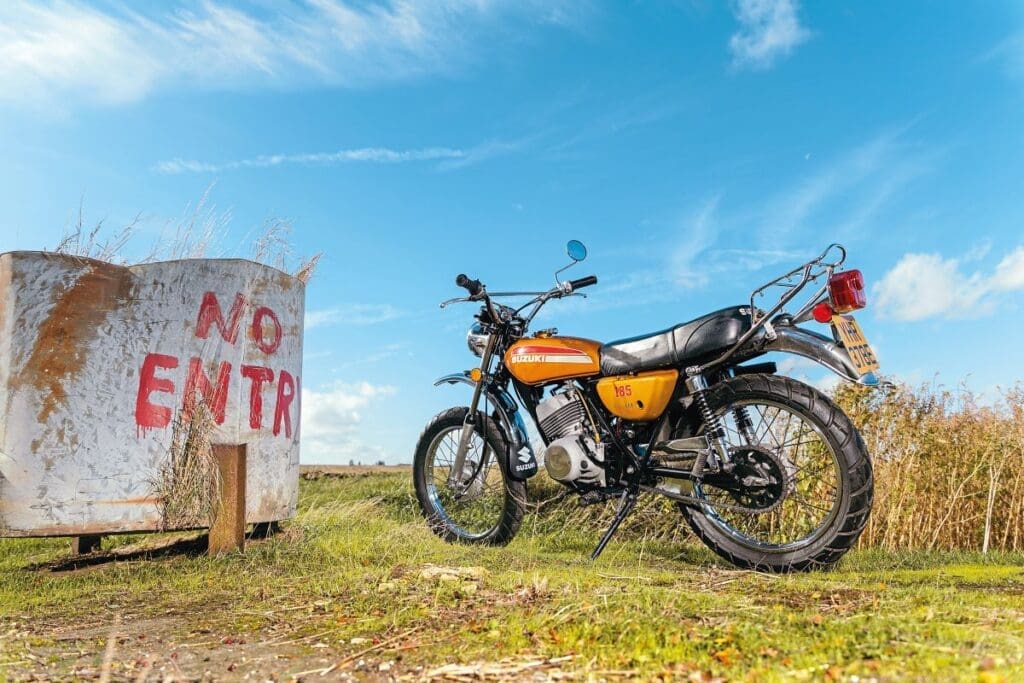
For everything else we can go back to our aquatic water fowl analogy – and this time it is very much akin to your average Mallard or Aylesbury. The controls, the feel, the ride, the handling are so much like the almost omnipresent TS185 you could almost be forgiven for thinking it genuinely is an American market Sierra – as they were called. The bike’s handling is again absolutely what you’d expect of a sub-250 trail bike with an added bonus of the Avon Trail Rider tyres which are infinitely more amenable than the OEM Inoue rubber that would have been fitted back in 1975. It’s all classic 70s except for one fundamental difference which is the torque delivery of the Ranger derivation here. Despite being based on the TS’s motor, the TC’s was tasked with carrying that fairly weighty copper armature on the left-hand end of the crankshaft. Without argument this additional lump must have some impact on how fast the engine gathers pick up but once it’s running the device’s effects play to the bike’s intended purpose. With that large mass already on the move the inertia stored within is absolutely delighted to carry on doing more of the same – laws of physics, etc. This translates into a juicy and rather handy punchy manner that makes the TC185 just that little bit different. Whether this facet of the power delivery was intentional or serendipitous is up for debate but the fact remains it adds a unique and subtly picante zest to the bike.
Ultimately the TC185 was something of a blind alley for trail bikes (see below) but an interesting one nonetheless. Sufficiently TS-like so as not to put potential punters off but with its own unique raison d’être, it wasn’t exactly common when new and is remarkably rare today… which make it all the more interesting to us Japanese classic fans now.
The owner’s view by Roy Hook
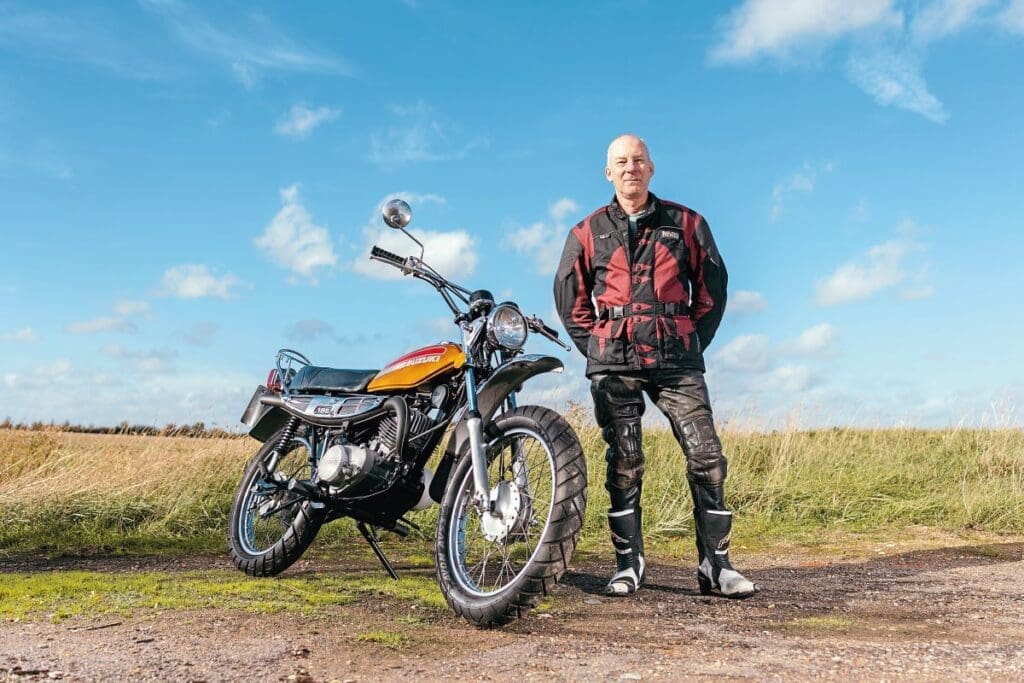
I wanted to restore another 70s bike so my wife Diane said: “Why don’t you do one from the year I was born?” Eventually I found this Suzuki TC185L on its way from Ohio destined to arrive at Somerset Classic Bikes in a few weeks’ time. It looked a bit tatty in the photos and even worse when it arrived at my place, but the main thing was it was all there except for the indicators. The bike was completely stripped to the bare frame, rubbed down and resprayed with rattle cans. The brackets, battery box, tool box, sump plate, foot pegs and anything else black were shot-blasted and sprayed. The tank and side-panel were just fine as they were; ditto the chrome. I stripped the engine and rebuilt it, replacing the main bearings and piston rings; everything else looked and felt okay. With new sprockets, chain and battery along with a pair of ‘adventure’ tyres the bike was ready for a road test. Some parts were hard to get as they’d been discontinued, but Robinson’s Foundry, CMSNL and Crooks Suzuki Parts were able to help in numerous instances. Other than that is was a case of looking online across America and eBay. It ran okay but I wanted to get the timing more accurate so spoke to CMM’s Mark Haycock who advised 3.07mm BTDC. Using my timing gauge and Mark’s settings resulted in the bike running much better – the timing had previously been too far advanced. With a new needle and carburettor clean, the bike is now a pleasure to ride.
From Suzuki’s TC to the TF
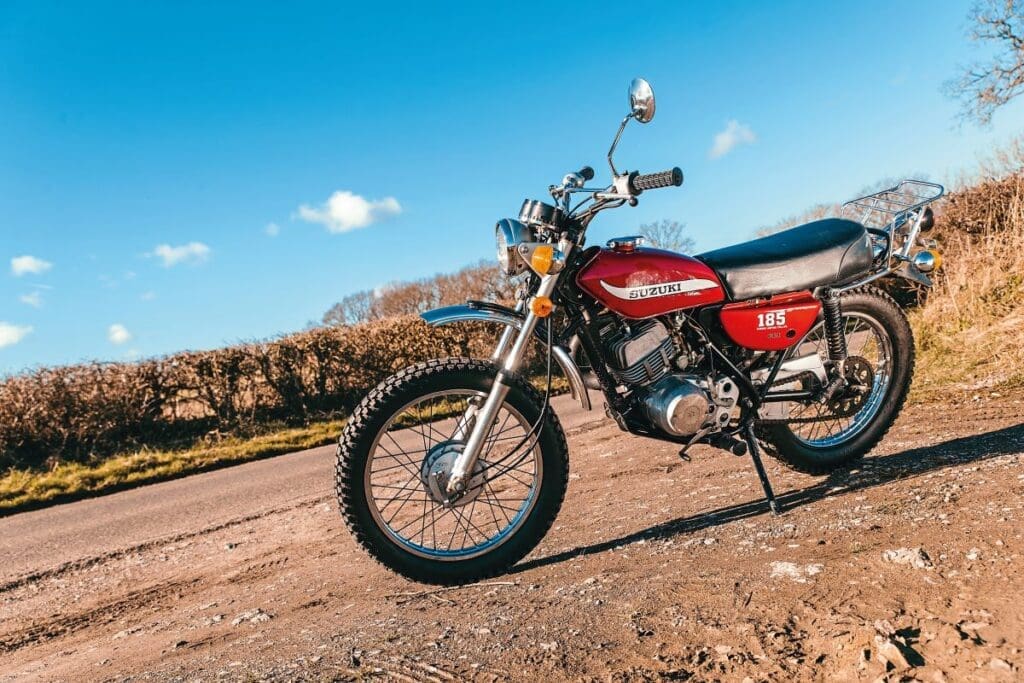
The TC185 is said to have been a pet project for one of the sons of the big boss at Suzuki and arguably not the greatest sales idea anywhere out of the USA.
There it was marketed to hunters and the like. For the likes of Australia and New Zealand it was pitched at farmers who welcomed its versatility. There’s not much data on the model but it doesn’t seem to have been sold at all in most of Europe. Although it looks like the TS, not many parts interchange, many are slightly different, and all engine castings are unique to the model. The starter dynamo unit is apparently sourced from the GT185 and runs a 12V system. The model only ran from 1973 through to 1976 before being dropped in favour of the TF range – presumably meaning Trail Farm. Three TF models, 100, 125 and 185, comprised the range and the trio were purpose-built for agricultural off-road use with little if any pretensions of being anything other. The TF ultimately did a better job than the TC185 and many are still in service today.
Specification
Engine type: 183cc air-cooled, two-stroke, piston-ported
Bore and Stroke: 64.0 x 57.0mm
Claimed Horsepower: 17bhp @ 7000rpm
Maximum Torque: 13.0lb-ft @ 6000rpm
Transmission type: 5-speed
Compression ratio: 6.2:1
Carburetion: VM26 Mikuni
Fuel Capacity: 1.5 gallons (6.8 litres)
Brakes: Drums (F&R)
Dry weight: 99kg (218lb)
Tyres: 2.75 x 21” (F) 3.50 x 18” (R)
